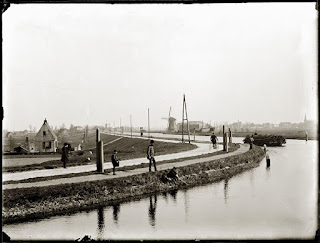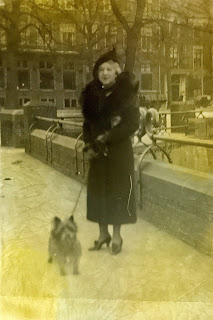Non-Population
Week 34 prompt. The federal census that we use in the US is sometimes comprised of more than one schedule. The one that we usually use is called the "population schedule." However, there are some censuses that have additional schedules. Have you found your ancestor on one of these schedules? What did you find?
Another way you could look at this theme is to write about something related to an ancestor, such as a church, school, or organization they were affiliated with.
For this week's prompt I have chosen the Haardstedegelde Registers 1672-1804. What are they?
Haardstede was another word for dwelling or homestead commonly used in 17th and 18th centuries in the Netherlands. Literally it means the place (stede) with a hearth (haard). Tax was payable and levied according to the number of horses a farmer took to the fields. The rate was one guilder per horse, and craftsmen and artisans paid the basic rate of one guilder plus an extra guilder. Those without any means such as skippers and peat workers paid just ten stuivers - pennies. The poor were exempt. The first haardstede gelden were levied in Drenthe in 1672 and then annually until 1804. (Wikipedia: Haardstede Registers)
Drente Archief has a background page which explains how they give an insight to the social status of a household. It was a type of property tax because it registered how many horses would be taken out to the fields, or sometimes the size of the farm - a full yard (erf) or half yard. The poor were exempted from this tax but were always listed. In 1742 aktes van remis (notices for deferral or discount) were noted for the needy, which show how much support they received.
The registers were kept in most places in 1672, 1691, 1744, 1754, 1764, 1774, 1784, 1794 and 1804. Sometimes there are additional registers or they started a bit later.
The ten-year spacing makes the registers very useful for establishing the history of dwellings in the 18th century. In general the official who maintained the registers would follow the same route through each village every time. They can be viewed in their original order and from this the location of the house can be worked out.
This the record for my direct ancestor Hendrik Jans Bloemberg in the Haardstedegeld Register for 1764 for Hoogeveen. It is the very last entry on the page. He owned one Praam and paid four guilders. So he had four horses, but what is a Praam? There are two meanings - a flat bottomed barge used to transport animals or goods on the rivers, creeks or a horse mouth harness to keep the animal calm. In this case I think it refers to the barge not the harness.
There is also a record for Henrick Jans Bloembergh in the register for 1691 who could be his grandfather. Henrick Jans paid just 1 guilder, which would mean that he had just one horse, so he was just a small holding farmer or in Dutch "kneuterboer".
I have to remind myself that these records do not list the birth dates, so I cannot be 100% sure that I'm looking at my direct ancestors. However, I think it is very likely as the location matches up with what I already know.
Scrolling through I notice other names from my family tree - Schonewille, Cattouw (Kattouw). So a little community emerges and I can see the possibilities for using this source to fill out more details and understand more about the lives of my ancestors.
Another way you could look at this theme is to write about something related to an ancestor, such as a church, school, or organization they were affiliated with.
For this week's prompt I have chosen the Haardstedegelde Registers 1672-1804. What are they?
Haardstede was another word for dwelling or homestead commonly used in 17th and 18th centuries in the Netherlands. Literally it means the place (stede) with a hearth (haard). Tax was payable and levied according to the number of horses a farmer took to the fields. The rate was one guilder per horse, and craftsmen and artisans paid the basic rate of one guilder plus an extra guilder. Those without any means such as skippers and peat workers paid just ten stuivers - pennies. The poor were exempt. The first haardstede gelden were levied in Drenthe in 1672 and then annually until 1804. (Wikipedia: Haardstede Registers)
Drente Archief has a background page which explains how they give an insight to the social status of a household. It was a type of property tax because it registered how many horses would be taken out to the fields, or sometimes the size of the farm - a full yard (erf) or half yard. The poor were exempted from this tax but were always listed. In 1742 aktes van remis (notices for deferral or discount) were noted for the needy, which show how much support they received.
The registers were kept in most places in 1672, 1691, 1744, 1754, 1764, 1774, 1784, 1794 and 1804. Sometimes there are additional registers or they started a bit later.
The ten-year spacing makes the registers very useful for establishing the history of dwellings in the 18th century. In general the official who maintained the registers would follow the same route through each village every time. They can be viewed in their original order and from this the location of the house can be worked out.
 |
| Hendrik Jans Bloemberg in the Haardstedegeld Register of 1764. |
There is also a record for Henrick Jans Bloembergh in the register for 1691 who could be his grandfather. Henrick Jans paid just 1 guilder, which would mean that he had just one horse, so he was just a small holding farmer or in Dutch "kneuterboer".
I have to remind myself that these records do not list the birth dates, so I cannot be 100% sure that I'm looking at my direct ancestors. However, I think it is very likely as the location matches up with what I already know.
Scrolling through I notice other names from my family tree - Schonewille, Cattouw (Kattouw). So a little community emerges and I can see the possibilities for using this source to fill out more details and understand more about the lives of my ancestors.




Comments
Post a Comment